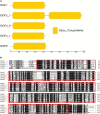RNAi-Mediated Knockdown of Imaginal Disc Growth Factors (IDGFs) Genes Causes Developmental Malformation and Mortality in Melon Fly, Zeugodacus cucurbitae
- PMID: 34290744
- PMCID: PMC8287652
- DOI: 10.3389/fgene.2021.691382
RNAi-Mediated Knockdown of Imaginal Disc Growth Factors (IDGFs) Genes Causes Developmental Malformation and Mortality in Melon Fly, Zeugodacus cucurbitae
Abstract
This study reports the first successful use of oral feeding dsRNA technique for functional characterization of imaginal disc growth factors (IDGFs) genes (IDGF1, IDGF3_1, IDGF4_0, IDGF4_1, and IDGF6) in melon fly Zeugodacus cucurbitae. Phylogenetic and domain analysis indicates that these genes had high similarity with other Tephritidae fruit flies homolog and contain only one conserved domain among these five genes, which is glyco-18 domain (glyco-hydro-18 domain). Gene expression analysis at different developmental stages revealed that these genes were expressed at larval, pupal, and adult stages. To understand their role in different developmental stages, larvae were fed dsRNA-corresponding to each of the five IDGFs, in an artificial diet. RNAi-mediated knockdown of IDGF1 shows no phenotypic effects but caused mortality (10.4%), while IDGF4_0 caused malformed pharate at the adult stage where insects failed to shed their old cuticle and remained attached with their body, highest mortality (49.2%) was recorded compared to dsRNA-green fluorescent protein (GFP) or DEPC. Silencing of IDGF3_1 and IDGF4_1 cause lethal phenotype in larvae, (17.2%) and (40%) mortality was indexed in Z. cucurbitae. IDGF6 was mainly expressed in pupae and adult stages, and its silencing caused a malformation in adult wings. The developmental defects such as malformation in wings, larval-larval lethality, pupal-adult malformation, and small body size show that IDGFs are key developmental genes in the melon fly. Our results provide a baseline for the melon fly management and understanding of IDGFs specific functions in Z. cucurbitae.
Keywords: RNA interference; Tephritidae; chitinase; mortality; wings malformation.
Copyright © 2021 Ahmad, Jamil, Fahim, Zhang, Ullah, Lyu and Luo.
Conflict of interest statement
The authors declare that the research was conducted in the absence of any commercial or financial relationships that could be construed as a potential conflict of interest.
Figures







Similar articles
-
Comparative transcriptomics of the irradiated melon fly (Zeugodacus cucurbitae) reveal key developmental genes.Front Physiol. 2023 Jan 17;14:1112548. doi: 10.3389/fphys.2023.1112548. eCollection 2023. Front Physiol. 2023. PMID: 36733910 Free PMC article.
-
Knockdown of the ecdysone receptor disrupts development and causes mortality in the melon fly, Zeugodacus cucurbitae.Insect Mol Biol. 2023 Dec;32(6):738-747. doi: 10.1111/imb.12867. Epub 2023 Aug 30. Insect Mol Biol. 2023. PMID: 37646607
-
Imaginal Disc Growth Factor 6 (Idgf6) Is Involved in Larval and Adult Wing Development in Bactrocera correcta (Bezzi) (Diptera: Tephritidae).Front Genet. 2020 May 6;11:451. doi: 10.3389/fgene.2020.00451. eCollection 2020. Front Genet. 2020. PMID: 32435262 Free PMC article.
-
Developmental Biology of Zeugodacus cucurbitae (Diptera: Tephritidae) in Three Cucurbitaceous Hosts at Different Temperature Regimes.J Insect Sci. 2015 Nov 20;15(1):160. doi: 10.1093/jisesa/iev141. Print 2015. J Insect Sci. 2015. PMID: 26589874 Free PMC article. Review.
-
A review of the current knowledge on Zeugodacus cucurbitae (Coquillett) (Diptera, Tephritidae) in Africa, with a list of species included in Zeugodacus.Zookeys. 2015 Nov 26;(540):539-57. doi: 10.3897/zookeys.540.9672. eCollection 2015. Zookeys. 2015. PMID: 26798277 Free PMC article. Review.
Cited by
-
Efficacy of lure mixtures in baited traps to attract different fruit fly species in guava and vegetable fields.Front Insect Sci. 2023 Jan 30;2:984348. doi: 10.3389/finsc.2022.984348. eCollection 2022. Front Insect Sci. 2023. PMID: 38468801 Free PMC article.
-
Argonaute1 and Gawky Are Required for the Development and Reproduction of Melon fly, Zeugodacus cucurbitae.Front Genet. 2022 Jun 23;13:880000. doi: 10.3389/fgene.2022.880000. eCollection 2022. Front Genet. 2022. PMID: 35812742 Free PMC article.
-
Comparative transcriptomics of the irradiated melon fly (Zeugodacus cucurbitae) reveal key developmental genes.Front Physiol. 2023 Jan 17;14:1112548. doi: 10.3389/fphys.2023.1112548. eCollection 2023. Front Physiol. 2023. PMID: 36733910 Free PMC article.
-
60Co-γ Radiation Alters Developmental Stages of Zeugodacus cucurbitae (Diptera: Tephritidae) Through Apoptosis Pathways Gene Expression.J Insect Sci. 2021 Sep 1;21(5):16. doi: 10.1093/jisesa/ieab080. J Insect Sci. 2021. PMID: 34718645 Free PMC article.
References
-
- Baig S. A., Akhtera N. A., Muhammad A., Asi M. R. (2009). Determination of the organophosphorus pesticide in vegetables by high-performance liquid chromatography. Am. Eurasian J. Agricult. Environ. Sci. 6 513–519.
LinkOut - more resources
Full Text Sources

